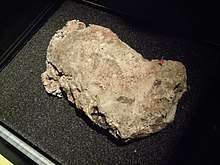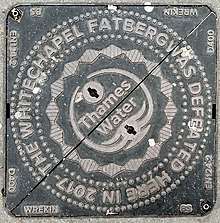Fatberg
A fatberg is a congealed mass in a sewer system formed by the combination of flushed non-biodegradable solid matter, such as wet wipes, and congealed grease or cooking fat.[1][2] Fatbergs became a problem in the 2010s in Britain, because of ageing Victorian sewers and the rise in usage of disposable (so-called "flushable") cloths.

Description
Fatbergs form at the rough surfaces of sewers where the fluid flow becomes turbulent. In pipes and tubes with smooth inner linings, fluid near the containing wall flows only slightly slower than fluid in the central channel of the pipe; thus, the whole volume of fluid flows smoothly and freely. When fluid encounters an obstruction, a resulting swirl of water starts trapping debris.
An obstruction can be any type of rough surface capable of snagging debris. In brick or concrete sewers there may be surplus cement drips, damaged brickwork, or loose mortar joints damaged by frost heave. In any sub-surface pipe, even of the most advanced design, penetration by foreign intrusions such as tree roots is a commonplace cause of a fatberg blockage.
In sewers carrying alkaline fluids, lipids can become calcified and solidify.[3] Comprising not only wet wipes and fat, fatbergs may contain other items that do not break apart or dissolve when flushed down the toilet, such as sanitary napkins, cotton buds, needles,[4] condoms and food waste washed down kitchen sinks.[1][5][6] The resulting lumps of congealed material can be as strong as concrete, and require specialist equipment to remove.[1]
In some areas, such as London, fat blocked in a sewer can react with the lining of the pipe and undergo saponification, converting the oil into a solid, soap-like substance.[4]
Grease and fat blockages can cause sanitary sewer overflows, in which sewage is discharged into the environment without treatment. In the United States, almost half of all sewer blockages are caused by grease.[7]
Fatbergs have been considered as a source of fuel,[8] specifically biogas.[9] Most of the fatberg discovered in Whitechapel in London in 2017, weighing 130 tonnes (130,000 kg) and stretching more than 250 metres (820 ft), was converted into biodiesel.[4][10]
Fatbergs can be mitigated through public awareness campaigns about flushable waste and grease traps for filtration at the source.[3] Campaigns have been launched against wet wipes because of their effect on sewer systems, most notably by Surfers Against Sewage and the Marine Conservation Society, among other environmental NGOs, who called on the UK's Advertising Standards Authority to end “misleading” branding and packaging.[11]
Occurrence
Fatbergs occur in sewer systems around the globe, in cities and smaller towns. Giant fatbergs have blocked sewers in London, New York, Denver, Valencia, and Melbourne.[12]
Etymology
| Look up fatberg in Wiktionary, the free dictionary. |
Fatberg is a compound of the words fat and berg, after iceberg. The word was used in 2008 to describe "large, rock-like lumps of cooking fat" washing up on beaches in Wales, and by 2010 was used in reference to sewer-blocking fat deposits in London.[13]
The word was added to Oxford Dictionaries Online in 2015.[14] The term is used by authorities at Thames Water[1] and South West Water,[15] both in southern England.
Notable fatbergs
- 6 August 2013: A fatberg roughly the size of a bus that weighed 15 tonnes (17 tons), consisting of food fat and wet wipes, was discovered in drains under London Road in Kingston upon Thames, London.[16][17]
- 1 September 2014: A solid mass of waste fat, wet wipes, food, tennis balls and wood planks the size of a Boeing 747 aeroplane was discovered and cleared by sanitation workers in a drain beneath a 260-foot (80 m) section of road in Shepherd's Bush, London.[18]
- 3 September 2014: The sewerage system beneath Melbourne, Australia was clogged by a large mass of fat, grease and waste.[19]
- January 2015: As part of a campaign against drain blocking, Welsh Water released a video showing a fatberg in drains in Cardiff.[20]
- April 2015: A 40-metre-long (130 ft) fatberg was removed from sewers under Chelsea. It took over two months to remove, and the damage it caused cost an estimated £400,000 to repair.[21]
- July 2015: A 120-metre-long (390 ft) fatberg was discovered in Welshpool in mid-Wales.[22]
- January 2016: A blockage caused by a fatberg near Newcastle, New South Wales, Australia, damaged the Eleebana sewage pumping station. The fatberg "weighed about one tonne (1.1 tons) and took four hours to remove" by crane.[23]
- September 2017: A 250-metre-long (820 ft) fatberg weighing over 130 tonnes (140 tons) was found under Whitechapel, London.[24] Even working seven days a week at a cost of £1 million per month, officials estimated it would take two months to destroy it.[25][26] Two pieces of the fatberg were cut off on 4 October 2017 and, after several weeks of drying, were displayed at the Museum of London from 9 February 2018 through June 2018, as part of the museum's City Now City Future season.[27][28] According to curator Vyki Sparkes, the fatberg became one of the museum's most popular exhibits.[29]

- September 2017: A fatberg of congealed fat, wet wipes, and waste was discovered under the streets of Baltimore, Maryland that caused the spillage of 1.2 million US gallons (4.5 million litres; 1.0 million imperial gallons) of sewage into Jones Falls.[30]
- April 2018: A fatberg discovered under South Bank in London is suspected to be larger than the one found under Whitechapel.[31]
- December 2018: Sewer workers discovered a fatberg in Sidmouth, Devon that was 64 metres long. Workers took eight weeks to remove it.[32] It was the largest fatberg discovered in the UK outside a major city,[33] and the largest in the history of South West Water.[15]
- February 2019: The largest fatberg in the UK was discovered in a sewer at Birchall Street in Liverpool. It weighed 400 tonnes and was 250 metres long. It is still (July 2019) being removed from the sewer as it is proving to be difficult to break-down using conventional tools and equipment.[34]
- December 2019: The first occurrence of a large fatberg in the north of England was reported by United Utilities under HM Prison Manchester. The 170 ft-long (52m) fatberg was estimated to weigh "around the same as three elephants", taking several weeks to remove fully.[35]
- April 2020: A 42 tonne fatberg the size of a petrol tanker was discovered in Melbourne, Australia. Its unusually large size in relation to other Australian blockages (far exceeding the 2014 and 2016 Australian fatbergs) was blamed primarily on the shortage of toilet paper caused by the COVID-19 outbreak.[36][37]
In popular culture
The 2020 Everything Everything single "Arch Enemy" has the narrator of the song praying to a sentient fatberg, willing it to destroy the world above the sewer it dwells in.[38]
References
- "Monster fatberg longer than two Wembley football pitches clogging up Whitechapel sewer". corporate.thameswater.co.uk.
- "Wet wipes could face wipe-out". BBC News. 8 May 2018. Retrieved 8 May 2018.
- "Don't feed the fatberg! What a slice of oily sewage says about modern life". The Guardian. 18 February 2018.
- "Fatberg! Exhibiting the Monster of Whitechapel". Museum of London.
- Williams, Rob (5 August 2013). "Britain's biggest ever 'fatberg' – the size of a bus and weighing 15 tonnes – found in London drain". The Independent.
- Edwards, Jim. "Gross Photos Show Sewer Workers Battling A 'Fatberg' The Size of a Boeing 747 Under London". Yahoo/Business Insider. Retrieved 1 September 2014.
- Report to Congress: Impacts and Control of Combined Sewer Overflows and Sanitary Sewer Overflows (Report). Washington, D.C.: United States Environmental Protection Agency (EPA). August 2004. pp. 4–28. EPA 833-R-04-001.
- "Kevin McCloud's Man Made Home". Channel 4.
- "Thames Water and 2OC in £200m deal to turn 'fatbergs' into energy". waterbriefing.org. 8 April 2013. Retrieved 2 June 2013.
- "'Monster' Whitechapel fatberg unveiled at London museum". BBC News. 8 February 2018. Retrieved 11 May 2018.
- "Wessex Water lodge 'flushable' wet wipes complaint with Advertising Standards Authority". Bath Echo. 21 September 2016. Retrieved 6 November 2019.
- Quevatre, Chris (20 January 2019). "War on fatbergs: Can this 21st Century peril be blitzed?". BBC. Retrieved 20 January 2019.
- "fatberg, n." www.oed.com. Oxford English Dictionary. Retrieved 23 February 2020.
- "New words in oxforddictionaries". Retrieved 28 August 2015.
- "The Sidmouth fatberg". South West Water. Retrieved 9 January 2019.
- 2013-08-06, Britain's biggest 'fatberg' removed from London sewer, BBC
- Flegenheimer, Matt (13 March 2015). "The Wet Wipes Box Says Flush, but the New York City Sewer System Says Don't". The New York Times. Retrieved 13 March 2015.
The consummate cautionary tale is that of London, where in 2013 a collection of wipes, congealed cooking oil and other materials totaled 15 tons, according to Thames Water, the utility company that removed it. It was known, like some previous occurrences, as the fatberg. "We reckon it has to be the biggest such berg in British history," Gordon Hailwood, an official with Thames Water, said at the time.
- 2014-09-01, Enormous 'fatberg' the size of an AEROPLANE found blocking sewers in London, Mirror UK
- 2014-09-03, Melbourne’s sewerage system clogged by fatberg, warns Yarra Valley Water, News.com.au
- "'Fatberg' found blocking Cardiff sewer". BBC News. 10 February 2015.
- Ratclife, Rebecca (21 April 2015). "10-tonne fatberg removed from west London sewer". The Guardian. Retrieved 21 April 2015.
- "120m fat blockage found in sewer". BBC News. 8 July 2015. Retrieved 11 October 2017.
- Cox, Dan (25 February 2016). "Wet wipes blockage weighing a tonne pulled out of sewer pipe near Newcastle". 1233 ABC Newcastle.
- "'Monster' fatberg found blocking east London sewer". BBC News. 12 September 2017. Retrieved 12 September 2017.
- News, ABC. "'Fatberg' found in Baltimore sewer system after overflow". ABC News. Archived from the original on 26 September 2017. Retrieved 26 September 2017.
- Johnston, Chris (10 October 2017). "Fatbergs: 90% of London restaurants are contributing to problem". The Guardian. ISSN 0261-3077. Retrieved 11 October 2017.
- Adams, Tim (4 February 2018). "London's fatberg on show: 'We thought of pickling it'". The Observer. Retrieved 10 February 2018.
- Knight, Sam (9 February 2018). "A Fatberg's Journey from the Sewer to the Museum of London". The New Yorker. Retrieved 10 February 2018.
- Coughlan, Sean (27 June 2018). "Mouldy fatberg draws crowds" – via www.bbc.com.
- Wells, Carrie. "'Fatberg' of congealed fat, wet wipes and waste discovered under Baltimore's streets, causing sewer overflows". The Baltimore Sun. Retrieved 26 September 2017.
- Fatberg 'autopsy' reveals growing health threat to Londoners, The Guardian, Nadia Khomami, 24 April 2018
- Morris, Steven (8 January 2019). "Sixty-four-metre 'fatberg' discovered in English seaside resort". The Guardian. ISSN 0261-3077. Retrieved 23 February 2019.
- "Monster fatberg found blocking Sidmouth sewer". BBC News. 8 January 2019.
- "Monster found in liverpool sewer". www.unitedutilities.com. Retrieved 22 July 2019.
- "Fatberg 'as heavy as three elephants' under prison". BBC News. 19 December 2019. Retrieved 20 December 2019.
- "The flushed items that caused a 42-tonne 'fatberg' in Melbourne". 7NEWS.com.au. 14 April 2020. Retrieved 14 April 2020.
- "Giant fatberg heavier than petrol tanker discovered in Melbourne sewer". www.9news.com.au. Retrieved 14 April 2020.
- "Everything Everything detail fifth album and release new song 'Arch Enemy'". NME. 13 May 2020. Retrieved 14 May 2020.